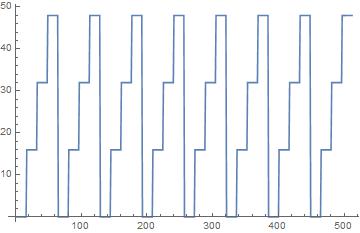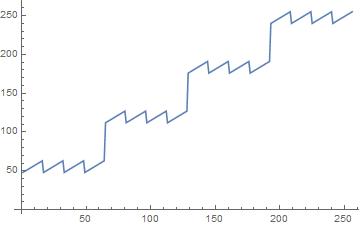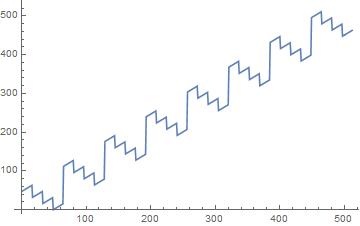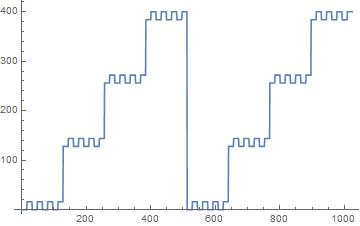Stuff about relationship between e, alpha, V.E., PSI and Pascal.."Alpha" == 8**10*x. Under Construction.
- Focusing only on 4-frequency V.E. seems a bit too easy but this is what we get about it. The volume of a 4 frequency Vector Equilibrium
is 20F³ (?) where F is Frequency == 20*64 == 1280. This is volume.
- Cumulative number of is spheres: 10(F12 + F22 + F32 + · · · + Fn2) + 2Fn + 1 == 18540. This is how many spheres are in
total from each layer added up in total.
- 0.018540 PSI == e!/2*60 Pascal. PSI is defined as Pressure per Square Inch. This is not a correct calculation
as the computer program we initially use had wrong precision. However since we convert from Pascal to PSI it might
be said that the conversion plays a part in this and that the calculation then is correct anyway. On the other hand
e is an irrational integer so we may never get a calculation that fits properly when an irrational integer like
e or pi is used in the calculation. However this is a good approximation and maybe it will show something what
e can be used for or e's relationship to spheres or the Vector Equilibrium structure. Details about this not yet.
- (?) This suggested that the PSI pressure of the "vectors" perhaps between the 18540 spherical
points in a 4 frequency V.E. is the same as it's number of spheres or vertexes / points albeit
in different scales 18540 vs 0.018540 or it's a good co-incidence but the actually PSI could
be as noted later here under "inter-relationship"..
- Bruce Cathie defines "(magnetic) lines of force per square centimeter" as much the same value (1850).
- As earlier noted 1/(144000/18540) give 0.12875, while e!/2*60 give ≃ 127.82461429071010145100363673937107,
the difference probably because we use geodesic speed of light in the former calculation. Also the
exponential of 10 is obviously wrong. Also of course note that the volume is exactly 1280 as noted above. Note
we use 144000 as geodesic miles per second speed of light where we convert ordinary nautical miles 162000
and divide by "grid-time" 27/24 or Synergetics constant S6 1.125. Also this calculation here might be said to be
true as the book says speed of light is not a constant so probably we could have 1/(x/18540) == e!/30.
- To get a value resembling alpha multiply 18540 by 160*216 ≃ 13733.3333333333333333.. , this is just
using more or less normal geometry-values 160 for the degrees inside some triangle and 216 just being
6*6*6. We could always try and shift the triangle however we want to get the Scientifically measures Alpha
as 1/x of this product. Also same as
- But thus further we have 18540*(160/216)/(e!*30)≃107.438879511107037419860704421782744874967. This is closer to
"Harmonic linkage between speed of light, in vacuum , and theoretical speed of light maximum (minutes/grid sec) the
book says 108.63561..is the value at equator but we assume just 108 should be logical and possible somewhere.
Also Bruce Cathie suggest "hydrogen atom in the terms of harmonic geodetic feet, then..circumference:
107.8321249*10^-11 geodetic feet".
- If we want to get previous figured alpha value we might consider multiply 18540 with piâ?´/720
logically. Otherwise earlier pi as 3.14125 might also be useful we have not tried.
- Could be though since its close to something like (1/144)/(512*pi²)
- Which of course is close to (1/128*pi²) never mind fractions..
- Maybe 1/(144*pi²) perhaps...or divided by a range of synergetics constants..
- It never ends but that was using 3.14125 initially though..
- It might point back to "alpha" being earlier 8**10*x, still.
- 8 is supposed to be an "analgesic" frequency, though. So it might be wrong after all. Lalana-chakra
anyone?
- Everyone calculates piâ?´ once it a while. It's called a "transcendent" digit and is up next:
- It's very roughly equal to 0.135290404213892273939500462067645987846843868989840863460..
- 18540/(piâ?´/720) is roughly 13348800/piâ?´ again.
- Which is (also a "transcendental" number): 137038.5439213302535729626732761140243604309613838464413722..
- In opposition to earlier value 137040.0.. look at this (alpha-2.html)
for that computation. N.B. this article i s denoted as "cathie100.html"..not "cathie-2.html"..
.
- Bi-JUNK. EOF..?
- Maybe it's 8 after all. That why the English serve those chocolates "after eight"..?
- Though from (n**2-n)/2 with 18540 as "n" we get 171856530.0 inter-relationships.
- I we fit 18540 "in a triangle" we get a similar digit 171875070.0 actually.
- Oh my, difference might be in the eye of the beholder but is: 18540.0!..
-
- 18540/x=137040 almost give us x=piâ?´/720 but still an albeit small difference, still a difference.
-
- If we replace 720 by 725 though and do like 1/(137040 / (18540/(pi ** 4/725))) we a result close to 1.00694444
which might mean something. The constant 7.25 is of course from ((1/(n*5/2)+1/(n*2/5))/(1/(n*5/2))) a tedious
expression. Though we have some other constants from similar expressions and even though they might not lead
to anything that looks like "alpha" they might lead to "something". Here to get to 1.00694444..we must try..
from this though we might do create a so-called scientific formula 1/(1/alpha)*(flux/(pi**4/725) something
like that.
(For 1/(137040 / (x/(3.14125 ** 4/725)))=1.0694444444444 we here use our "static" pi and variable for flux,
which turns out to be 19682.4 an unknown variable but relates to 10440 and give 1957.5 and then with x
for alpha we get alpha back at 13629.2. From this last one we get 5832*sqrt(6/log(3)) almost 13629.217248,
where specifically 5823 is 27²*2*2*2. One should think reading up on a web-page on the fine-structure
constant Alpha with a bit of Zen things should become more evident. The web states that it should be
2pie2/hc = 1/137.03599913 (1) or what interest us is that "One use of this curious number is to measure
the interaction of charged particles like electrons with electromagnetic fields." (1) this interest
us because the formula we are working with here was about alpha , 18540 which earlier is stated is
magnetic lines of force per square centimeter, and thus we could s*** our own attempts at alpha
and try 1/(137035.99913 / (18540/(x)))=1.0694444444444.
1/(137035.99913 / (18540/(x)))=1.0694444444444 to x=0.12650766227, ..we could also try and use Bruce Cathie's
unit ..also why a page (1) both suggest this constant is a puzzle and then give us a solution is just wrong.
Anyhow we have found that the value must be related to 18540 maybe we can go back to the 4-frequency
V.E...
..actually this is all a loss somebody can figure it out or we will wait until we have a machine
ready based on this which we can tune.)
Actually with alpha based on ((n-1)/(2*a)) where a is 2.9 and n == 800000 the after-eight constant,
we get alpha back at 137930.8620689655 and if we chose static pi 3.14125*x instead of pi**4/725
then x will be close to 0.04 (which is also the Frequency of the VE we're using) we get 0.04011
think we would go for this solution other than pi as x almost 3.14217 for 0.04. Otherwise we could
think of converting 18540 to some other unit there's just so much to do with this.
- And so it is. 18540/(pi�/0.16) is ≃ 30.45300976029562, i.e. "Harmonic Linkage between speed of light, in
air, and speed of light, in vacuum", a slight offset from the printed value but close enough. The difference being
though that this is "coded" from a single mathematical expression. 0.16 = ((1/(n*5/2))/(1/(n*2/5))) also so
is this value some cosmological constant we've seen before? "Lesser" plancks constant or something?
- Thus we might also want to know what pi�/0.16 is and that is ≃ 608.8068189625151.
- We have (18540/(pi ** 4/725*0.16))/6 which is 143739.79216285367 which without /6 is 862438.752977122
too close to Field B lines of force per square geodetic inch, though we are jumping now from centimeter to inch
so it might not be right. But if it is possible to make system out of this why not do it with math.
- pi**4/720*0.16 is thus ≃ 0.021646464674222758..
- If we remember sum 1 to 144 is 10440 end use the harmonic 1044/2/2*0.16 we arrive at simply 41.76 which we wanted
to , to get a static value for gravity acceleration.. 41.76/6=6.96. Thus with (1/144)*6 though we might as well assume
that it's Harmonic 0.04166666666666666. Though 0.041666666666666664*41.76 is 1.7399999999999998 or possibly 1.74,
which sounds right because 1.74/2.9=0.6. So 10440/6 is also 1740.
- And finally sqrt(1740) is 41.71330722922842 almost as printed.
- Though this value divided by 2.9 give a speed of light value not exactly 0.016 below max but if we assume
so we get harmonic 14.384*2.9 == 41.7136, so there are too many ways to look at this.
- Though the last one would mean (41.7136**2)*6 ≃ 10440.14654976 which might not be quite right if one doesn't
think that 10440/x here = 1.0000140373333333 and that the latter digit here looks good and could be another viable "constant".
- Yet again it does now give us exactly 1.0069444 though but of course if that was the case..something or another would
probably be certain. But no , it isn't. I.e 720*x=y -> 725/y = 1.006930309828042..
- Though 10440 still has out attention.
- 10440/(725/720)/0.16=64800. This value is suppose to be related to the coulomb. Maybe.
- Electron-flow 6.25*10^n per second is 1 (ampere) and the Coulomb. So we have 10440/625=16.704 to x/16=1.044 and 10440/16.704 is of course 625.
- Though , 10440/(725/720) in the equations above is 10368 which is exactly 72 less than 10440.
48 has been on our minds for some reason, It turns out to be the product of (1152*6)/(1/144) at least (also just 6*8 of course).
And a plot might look like this (48&x):

And 48|x seem to give an ever increasing graph:

And for 48^x (range 512):

All three graphs are in essence variations on the same idea it seems. 1152*6=6912 is also 144*48 should be noted. And 144/48=3.
And there are of course many more calculations that can be done with these numbers. The only one we might mention here that we should
and haven't done yet it is 144/(1/144) which is 20736 which fit 2nf²+2 where n is 2 and f 72 though lacking +2 which would make it 20738.
On a side note 145/144 = 1.0069444444444444 and 145/(1/144)=20880. We might look at this one with 20880&x before we proceed and
the sequences creating it is (0 and 16, 128 and 144, 256 and 272, 384 and 400 ):

What kind of resonance or what, these wave-forms would be is kind of hard to say. It may seem like a bit rubbish to make these wave-forms
but at least it's fun. They are properly harmonic and geometric though and for the sub-conscious mind / the brain, though. Some
other ones are shown here (though we have not added the part about biological interest there).
Though mentioning these waves and their biological function in our view does not mean that they don't need to have a relation to
physics or quantum physics too. It may seem fascinating that "concepts" like this might be applicable many places in the Universe,
like this both physics etc, and brain etc, though there should be a logical explanation to this.
Why we push for them to apply biologically first though that is because if Man can use these wave-forms biologically, he may also
use them otherwise. Hopefully it is enough to just see these wave-forms for them to take root and have function biologically.
"Concepts" are many places. And electron is said to have to spin about 720 degrees to get to where it started. A normal simple knot
on a rope is also 720 degrees. Thus even though Newton is not in fashion..and Speaking of Newton it is said that he understood the
concept of mass attraction or gravity when he saw an apple fall to the ground. The question is though about if his mind though in
these conceptual ways perhaps in relation to the form of the apple or not. The Earth is generally though of having a north and south
pole but a compass only points North. As such an apple only has one flower also. Everybody knows the Earth is not an apple though.
Earth is an orange of course..and in Norway possibly all of Scandinavia and maybe even the Norse countries the word for Orange is
"Appelsin" so there you have it kind of.
720 might not be the exact proper spin though. Bruce Cathie has suggested 741.90399 degrees, which might be right. We suggest 725
but 725/720 is 1.0069444444444444. Earlier we found the constant 1.0000140373333333 and we could use that one with the former one here
and get about 725.0101770666666 which certainly could be relative as well. Perhaps the spin of the electron is dependant on energy-level
the electron is at, everything possible. Also it's possible that everything is just energy anyway going about in various geometric
arrangements. One could also say that there are not any "particles" really just "something" that behaves as such (for us).
As such though , regarding the above statements about that everything really boils down to energy and energy-configurations it might
seem fantastic that C.E.R.N. can find various particles etc in their work, with their photon -accelerators and such, but what they might
be doing is isolating various energy packets fitting their already established frame-work that has a long (well, not fantastically long)
history, and using them to find new "particles" thus expanding their frame-work. In that sense it seems like a gigantic waste of money
considering how much is spent on these machines which could be better used for Humanity otherwise?
Thus some of the point of this site is to developed a viable mathematically frame-work that can model energy's behaviour anyway, even
if Buckminster Fuller's "Synergetics" sometimes is considered a "space-case" (foolish) study. Of course a bit of our time here goes to
correlate Synergetic Vector Geometry with already established science to prove things.
One such proof is the fact that e!*30 Pascal to PSI equals the value of a 4-frequency V.E..We have not ventured far into the depths of
e or e! in relation to the V.E. etc, but we think it suffice to show that this normally used constant can be fitted nicely in relation to Synergetics.
Despite that engineers out there reading this wanting to make their own technology might find it interesting due to the fact that one component
of an already built machine might have reference to e , while the new additional components might be deemed sufficient to relate to
Synergetic Vector Geometry. Thus modern science has not been futile after all, and one must remember Synergetics was not developed until
the 60's?
What anyway is kind of difficult is to say consider this spin, lets just say its 725 degrees. How can we picture this to understand properly
why it should be so? This is difficult but well worth it as it gets us away from theory to practice. We might consider it not identical
but similar to Earth with it's spin and orbit around the sun. There are countless suns with planets spinning and going around them in orbits,
so somewhere we might find one such systems that would make on orbit around the ..core, and one regular spin of 360 degrees equal in a way
to totally 725 degrees when added up, for instance. Though even if this might only represent an extremely "basic" way to look at an energy-packet
like the atom, which has been shown by measurement to if it's not exactly equal to solar system, it's at least far more complex.
But this a bit more complex although similar in one sense, arrangement to solar systems, when viewed on a smaller scale is a such yes, on a bigger
scale like electromagnetism we can see that it will be simpler again. Thus the 18540 magnetic lines of force per square centimeter on the Earth's
surface can probably be seen and it's not such a big number. But if we are to believe Synergetics we might "magnify" again to get back to the
more basic complex level. What we wonder though is that if it anyway despite being very complex has a pattern we can discern like would it
fit the formula for interrelationship printed above: "Though from (n**2-n)/2 with 18540 as "n" we get 171856530.0" would we find 171856530
micro-lines of force perhaps? Would this relate to fractals of we're lucky? We will try to find at some point though this should not be
.e. the surface of a fractal because in fact a fractal in the normal sense have infinite surface-area
The large hadron-collider as it's called though (property of C.E.R.N) proved a few dismal things though when they were searching for the so-called
"God particle" i.e. the Higgs-boson. There were some ideas before they found it and measured it's "energy-level" correctly like the notion that
the Universe "had a lifetime greater than it self". If there's something we love it's paradoxes and they ruined that thoroughly by measuring the
energy-levels of the higgs-boson refuting the fact about this "lifetime".
The number e is said to be irrational just like pi which means if you try to print all the decimals they trail of the screen and into the flat
next door, out his window and far beyond never ending. "e!30 Pascal to PSI" seem like a pretty normal number though. so it can't be so very
irrational. You might say the calculation with e that gave us 18540 is not precise enough but we'd just work backwards from 18540 then and surely
we wouldn't find an irrational number then either.
In a sense though since e!*30 doesn't give exactly 128 pascal even if the pascal it does hand use give the V.E. that has a volume of 1280. Since this
is so we need to derive some constants obviously. Maybe e!*30 "should have been" 1280 Pascal or something, but the thing is of course that the conversion from
Pascal to PSI is a bit like the stuff about normal and geodetic inches, for instance. That physics already is like a Picasso image like this though
is nothing we appreciate. That is that if we are lucky and a 4-frequency V.E. should turn to actually be related said magnetic lines, then it would
be strange the 18540 which is it's number of spheres or the amount of spherical points on the figure, ..it should be strange that this isn't related
to exactly 128 Pascal, even despite that it's volume is a decimal exponent of that even (1280). We've not studied many V.E. but could the latter
maybe be the case that Pascal could very well be volume/100 if the conversion was slightly different then the one we use today? Of course then that
wouldn't fit so nicely with the irrational constant e.
Talking about e though. e as mentioned is an irrational number just like other like pi. One could assume then thought that using it in some
equation we should never get a whole natural number like 18540 as it wouldn't be very irrational then. Surely there is some "rounding" error
in 18540 where the computer calculating for has has use some approximation of e. In case that though wouldn't stop us from working out
18540 PSI to Pascal to x!*30 for instance to find a less irrational constant.
Ok we've mentioned the stuff just above twice now, well it's always nice
to repeat. Also worth to note though we seem to remember checking WIKI for any reference to scientific or physics use of it, and WIKI didn't
mention any so e is not directly a "physical constant" though that doesn't mean it's not used in say calculus in physics anyway. Though from
this stuff here it certainly seems to be a constant having real scientific and physics relation. We might for instance say that e! Pascal
represent a physical quantity of this or that energy-form / packet / whatever, maybe.
Another interesting thing about the 4-frequency V.E. that even if it seems go give a very fitting value for these magnetic lines of force
the problem is that we can't exactly prove it, and that is not good. But we might look at some of the other properties of the diagram and
see if that helps us. We've seen that the value is very close to 128 Pascal and 128 Pascal might be said to be the inverse (1/x) of
Schumann Resonance. We don't know if Schumann Resonance can be measured in Pascal but that's another measure. Also the volume of the
4-frequency Vector Equilibrium is 1280 which might also be said to be the inverse of Schumann Resonance even if it has a decimal shift from 128,
but that does't mean that say neither 128 not 1280 has wrong magnitude or their values are simply a case of the value appearing as pico-whatever
in contrast to the normal micro-whatever, so to speak. That stuff actually seem to be another conflict we have with established physics that we develop
exact mathematical and geometric stuff while we don't know what established science does.
Yes as such the Schumann Resonance has never anyway been shown to be some 10**n (due to this micro, pico, milli stuff) multiple of 1/128=0.0078125
anyway. So that one might require an additional "thing" so that that one doesn't seem completely liable to be haphazard either. Well it turns out
that (1/128)/S6 (Synergetics Constant 6: 1.125 or 9/8) is as such exactly equal to the propose gravity constant: 0.006944444444444444 even though the
decimals might not be correct here either. This though we have noted before.
Though the really interesting thing here in total. That would be that mathematically and geometrically it could link both Magnetism, Schumann
Resonance, and also the Gravity constant, and of course the (irrational) constant e. As such we might very well say that is it a few
interesting things that we are discussing here if they all should turn out to be true in some sense.
1.012: Another variable and "binary belts".
We have state on the front page: 2*(225|144^256), which we modify to: (225|144^256&225) here we have removed 2* and made it out to
be a circle which stops after the second iteration of 225. This gives us (225|144^256&225)=241. And we can add at lest *2 again
making it 2*(225|144^256&225)=482 or perhaps since we're at "round 2" which should add *4 making it 4*(225|144^256&225)=964.
Otherwise we could have 1000-241=759 to 759/750=1.012 ..which looks like 1024 but isn't missing 12.
Also 33310 in base-4.
INDEX.



